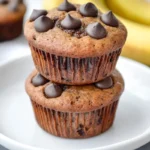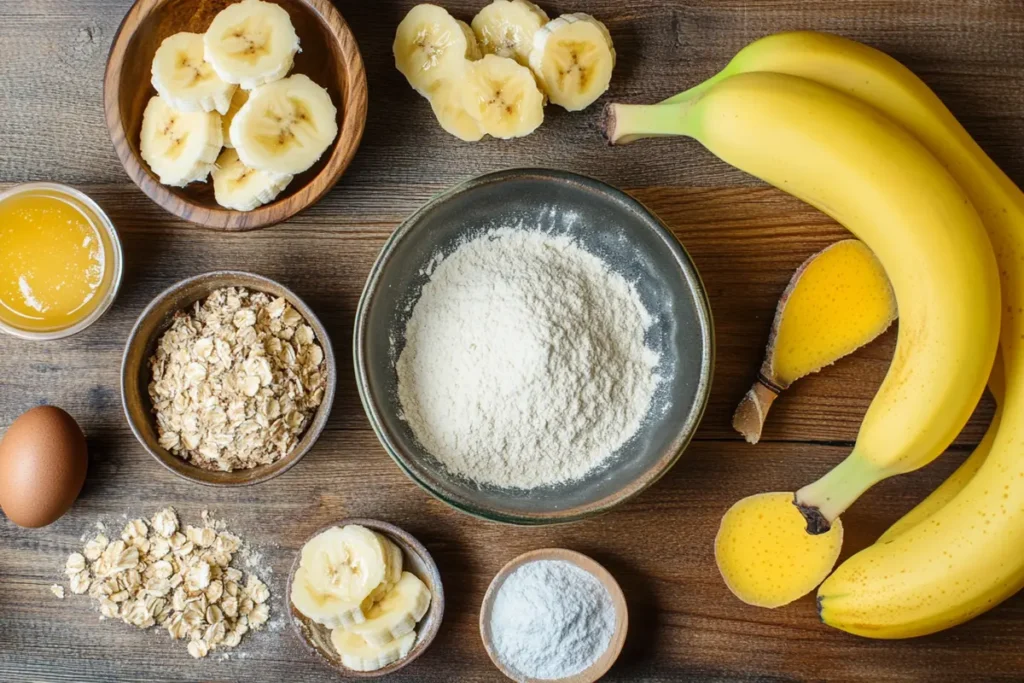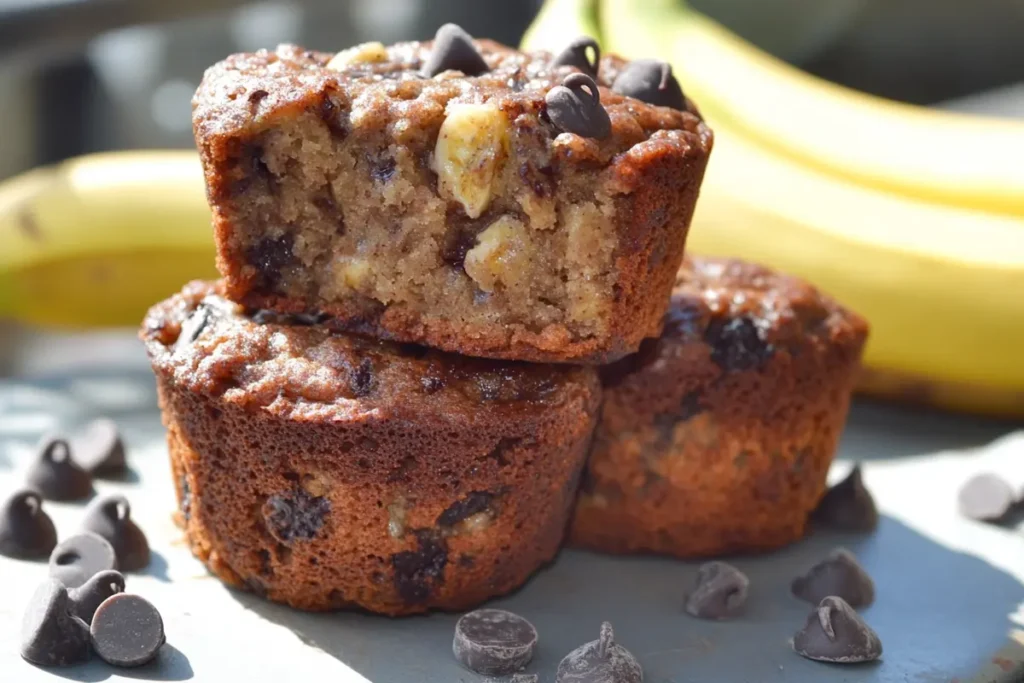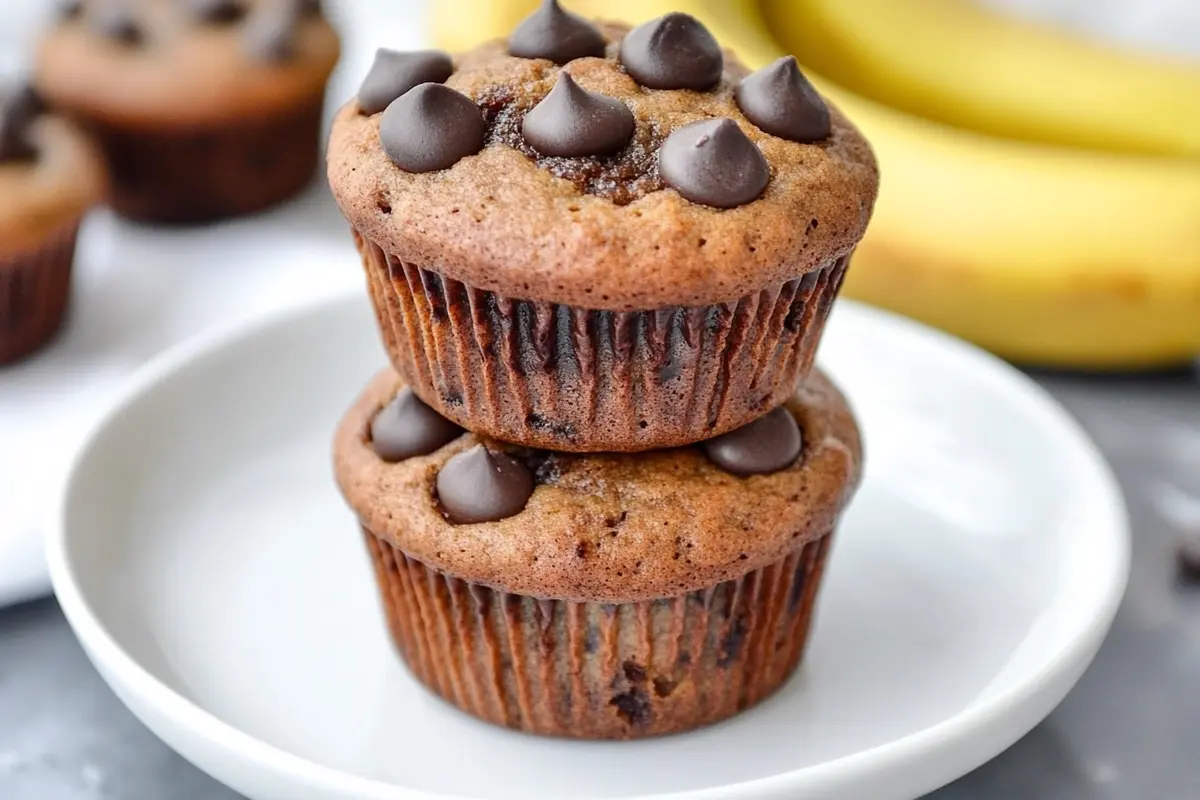Delicious gluten free banana bread muffins are a fantastic treat for everyone, especially those with dietary restrictions. These muffins offer a simple, tasty way to enjoy a classic flavor. This article explores everything you need to know about baking perfect gluten-free banana bread muffins and includes tips for success.
Table of Contents
Understanding the Appeal of Gluten-Free Banana Bread Muffins
Gluten free banana bread muffins have gained popularity. This is largely due to the increasing awareness of dietary needs and restrictions. Many people seek tasty alternatives without gluten. Moreover, the convenience of a muffin makes it a preferred option for many. These muffins provide a perfect single-serving treat. They are easy to grab for a quick breakfast or snack. Besides their convenience, they are incredibly delicious. The sweet taste and moist texture make them a favorite. Therefore, whether you’re gluten-free or not, these muffins are a great choice. You can learn more about our gluten free journey by exploring our website.
Print
Delicious Gluten Free Banana Bread Muffins: A Powerful Guide
- Total Time: 35 minutes
- Yield: 12 muffins
- Diet: Gluten Free
Description
Whip up a batch of incredibly moist and flavorful gluten-free banana bread muffins! Made with simple ingredients and ripe bananas, these easy muffins are a perfect healthy breakfast or snack that everyone will love, whether they follow a gluten-free diet or not.
Ingredients
-
3 ripe bananas, mashed (about 1 ½ cups)
-
2 large eggs
-
1/3 cup melted butter or coconut oil
-
1/2 cup brown sugar (or maple syrup)
-
1 tsp vanilla extract
-
2 cups gluten-free flour blend (with xanthan gum)
-
1 tsp baking soda
-
1/2 tsp salt
-
1 tsp ground cinnamon (optional)
-
Optional add-ins: 1/2 cup chocolate chips or chopped walnuts
Instructions
-
Preheat: Preheat oven to 350°F (175°C). Line a muffin tin with paper liners or grease well.
-
Mix Wet Ingredients: In a large bowl, mash the bananas. Whisk in the eggs, melted butter/oil, brown sugar, and vanilla until smooth.
-
Combine Dry Ingredients: In a separate bowl, whisk together the gluten-free flour, baking soda, salt, and cinnamon.
-
Combine: Gently fold the dry ingredients into the wet ingredients until just combined. Do not overmix. Fold in any optional add-ins.
-
Bake: Divide the batter evenly among the muffin cups, filling each about 3/4 full.
-
Bake: Bake for 18-22 minutes, or until a toothpick inserted into the center comes out clean.
-
Cool: Let the muffins cool in the pan for 5 minutes before transferring to a wire rack to cool completely.
Notes
Don’t Overmix: Overmixing is the #1 cause of tough, dense gluten-free muffins. Mix until the ingredients are just combined.
Flour Blend: Using a good-quality 1:1 gluten-free flour blend that includes xanthan gum is crucial for the right texture.
Banana Ripeness: The riper the bananas, the sweeter and more moist your muffins will be.
Storage: Store cooled muffins in an airtight container at room temperature for 2-3 days, in the fridge for up to a week, or freeze for up to 3 months.
Add-Ins: Feel free to add chocolate chips, nuts, or even a swirl of peanut butter for extra flavor.
- Prep Time: 15 minutes
- Cook Time: 20 minutes
- Category: Breakfast, Snack
- Method: Baking
- Cuisine: American
Nutrition
- Serving Size: 1 muffin
- Calories: ~180 kcal
- Sugar: ~12g
- Sodium: ~220mg
- Fat: ~6g
- Saturated Fat: ~3.5g
- Saturated Fat: ~2g
- Trans Fat: 0g
- Carbohydrates: ~30g
- Fiber: ~2g
- Protein: ~3g
- Cholesterol: ~40mg
The Basics of Making Gluten-Free Banana Bread Muffins
Baking gluten-free banana bread muffins requires understanding a few key differences. These differences will impact your baking compared to traditional wheat-based baking. First, you will need gluten-free flour. Not all gluten-free flours are the same, as they can vary in their composition. This variance affects the final product significantly. For instance, some flours might be drier, while others might provide a better texture. Therefore, using a good gluten-free flour blend is essential. Second, the amount of liquid and binding agents can be different. Gluten-free baking often requires additional moisture to prevent dryness. Ingredients like eggs and yogurt help in binding, creating a better structure. In addition, it is important to measure ingredients with precision.
Choosing the Right Gluten-Free Flour
Selecting the proper gluten-free flour is crucial. The flour plays a key role in the texture and rise of the muffins. Many options are available, each with its own set of qualities. Almond flour, for example, offers a slightly nutty flavor and a dense texture. In contrast, rice flour is lighter but can be a little dry. Gluten-free blends, that combine several flours, are usually the best for consistent results. These blends typically include rice flour, tapioca starch, and potato starch. You can also use a commercial gluten-free flour blend. This can make the process easier and more reliable. Therefore, always read labels carefully to understand the blend composition.
Essential Ingredients for Great Gluten-Free Banana Muffins
Making delicious gluten free banana bread muffins starts with great ingredients. These include ripe bananas, which provide natural sweetness and moisture. Overripe bananas are ideal because they are sweeter and easier to mash. You’ll also need gluten-free flour, eggs, and a type of oil or melted butter. Butter usually gives a richer flavor. However, oils like coconut or canola also work well. Sugar is essential for sweetness, and you can use brown sugar for a more caramelized taste. Baking soda is also important. It helps the muffins rise, while baking powder is sometimes used as well. Moreover, flavor enhancers like vanilla extract and spices like cinnamon are very important.
Step-by-Step Guide to Baking Gluten-Free Banana Bread Muffins

Now, let’s move to the actual baking process. First, preheat your oven to 350°F (175°C). This ensures the oven is ready when you put in the muffins. Then, mash the ripe bananas in a bowl until they are smooth, but not completely liquid. Next, beat the eggs with sugar in a separate bowl. This creates a nice base for the batter. Add the oil or melted butter and vanilla extract to the mixture. Mix them thoroughly. Combine the dry ingredients, such as the gluten-free flour, baking soda, and salt, in a different bowl. Add them slowly to the wet mixture, mixing until everything is just combined. Avoid over mixing the batter.
Tips for Moist and Delicious Gluten-Free Muffins
Baking gluten-free often presents unique challenges. It can be hard to get a moist texture. One trick is to add an extra liquid like yogurt or applesauce. This will keep them moist for days. Moreover, avoid overbaking the muffins. This will make them dry. Keep an eye on them during the last part of the baking. Another important factor is to not overmix the batter. Mix until the ingredients are just combined. Overmixing will make your muffins tough. Furthermore, using the correct gluten-free flour blend is important. These blends are designed to provide the best possible texture. Finally, ensure that your bananas are very ripe. Ripe bananas contribute moisture, making them soft and delicious.
Enhancing Flavor in Gluten Free Banana Bread Muffins

There are many ways to enhance the flavor of your gluten free banana bread muffins. Spices such as cinnamon, nutmeg, and cloves will give them a warm flavor. You could try a combination for a more complex taste. Adding a little bit of ground ginger will give a subtle kick. Furthermore, you can experiment with extracts. A bit of almond extract can compliment the banana very well. Also, adding chocolate chips or nuts will make a significant difference. Chocolate will provide an indulgent twist, while walnuts will offer a nutty flavor and a nice crunch. You can also use dried fruits, such as raisins or cranberries. Another option to consider is a streusel topping.
Making Gluten-Free Muffins Healthier
It’s possible to make gluten free banana bread muffins healthier. Reducing the amount of sugar is a great way to go. You can use natural sweeteners like honey or maple syrup, but you should also use them in moderation. Additionally, you can swap refined flour with whole-grain gluten-free options. Oats and almond flour are great options. They contain more fiber and nutrients. Another way is to incorporate other healthy ingredients. Adding flax seeds or chia seeds will boost the fiber content. Greek yogurt instead of oil adds more proteins and calcium, without adding extra fat. Furthermore, using ripe bananas reduces the need for extra sugar. These changes will give you a healthier treat with the same classic flavor.
Storing and Freezing Your Gluten-Free Muffins
Proper storage will keep your gluten free banana bread muffins fresh for longer. First, let them cool completely after baking. Then, store them in an airtight container. This way, they will stay moist at room temperature for 2-3 days. For longer storage, you can put them in the refrigerator. This will extend their life for up to a week. If you wish to store them for longer, freezing them is also a good option. Place the cooled muffins on a baking sheet, and flash-freeze them for about an hour before transferring them into freezer bags. This will prevent them from sticking together. When you are ready to eat them, let them thaw at room temperature.
Troubleshooting Common Issues with Gluten-Free Baking
Baking gluten-free can sometimes be difficult. However, it can be improved by troubleshooting a few common issues. If your gluten-free muffins are too dry, you are probably adding too much flour. Always measure carefully and use a good flour blend. Moreover, you might also be overbaking them. If your muffins are too dense or don’t rise, you might need more baking powder or baking soda. Remember that gluten-free flours absorb moisture differently. Therefore, adjust the liquid content accordingly. If the muffins are gummy, you might have added too much liquid. Try to reduce the liquid or add a bit more flour. Another issue is uneven baking, which usually happens if your oven has hotspots.
Why Choose Gluten-Free Options?
Choosing gluten-free options is not just a trend. It is a dietary need for some people. Those with celiac disease or gluten sensitivity must avoid gluten. This protein is found in wheat, barley, and rye. It is known to cause many symptoms such as digestive discomfort, fatigue, or inflammation. Moreover, many individuals find that removing gluten helps them feel better. Even people without gluten sensitivities have noticed some positive health impacts. Additionally, gluten-free baking can also introduce new flavors. Many alternative flours have a unique taste and texture. Thus, choosing gluten-free helps some and enhances flavor for others. This makes gluten free banana bread muffins a great choice for many people.
Gluten-Free Banana Bread Muffins: A Great Choice for Many
Gluten free banana bread muffins are a great choice for many reasons. They are tasty, easy to prepare, and convenient for grab-and-go meals. Therefore, they are ideal for busy mornings or after-school snacks. Moreover, they provide a simple way to accommodate different dietary needs. Anyone with gluten sensitivities can enjoy them as well. The flavor is sweet and comforting, bringing back memories of classic banana bread. In addition, you can personalize these muffins according to your preferences. Adding extra spices, nuts, or chocolate will enhance your experience. Thus, gluten-free banana bread muffins are a winning combination for taste and convenience. If you’re interested in other gluten-free treats, see our article on gluten-free brownies.
Different Variations of Gluten-Free Banana Bread Muffins
You can also try different variations of gluten-free banana bread muffins. For instance, you can use different sweeteners. Maple syrup or honey are a great alternative to sugar. You can use various types of gluten-free flours. Almond flour or oat flour each offer a slightly different texture. Moreover, you can add different flavorings, like orange or lemon zest. Adding a teaspoon of espresso powder will give your muffins a subtle mocha flavor. You could also include different types of chips, such as peanut butter chips or white chocolate chips. Another idea is to make them with a swirl of peanut butter or jam on top. You can also make them vegan using flax eggs and non-dairy butter.
Gluten-Free Baking: A Rewarding Experience
Gluten-free baking might seem complex. However, it’s really rewarding. Once you understand the basics, it becomes very easy. There are a few key steps to success. First, measure accurately. Second, select the best flour blends. Third, do not overmix the batter. Fourth, keep an eye on the baking time. With some practice, you’ll be able to master this. The result is delicious and tasty treats that anyone can enjoy. You will discover a new world of flavors and textures. This can be a great way to explore your creativity. Furthermore, it can accommodate people with specific needs. It can be very satisfying to bake great gluten-free treats. You can try our other easy and tasty gluten-free recipes.
The Joy of Sharing Gluten-Free Banana Bread Muffins
One of the greatest joys of baking is sharing your creations with others. Gluten free banana bread muffins are great to make for friends, family, and neighbors. They are a thoughtful treat for people with dietary restrictions. These muffins are perfect for gatherings, brunches, and potlucks. Also, they are a wonderful gift for any occasion. You can even make them with children. Baking together is a nice experience for children of all ages. Therefore, sharing your home-baked muffins will bring smiles to others. They’re a simple way to show you care. Sharing brings people together and makes everyone happy. It is something that is very rewarding and special.
Conclusion: Enjoying Delicious Gluten-Free Banana Bread Muffins
In conclusion, making gluten-free banana bread muffins can be both fun and rewarding. They are a tasty and versatile snack that can be enjoyed by everyone. Whether you follow a gluten-free diet or not, these muffins are delicious. With the right ingredients and some simple tips, you can bake moist and delicious muffins. They are perfect for breakfast, snacks, or dessert. You can use different types of flours and flavors. So, don’t be afraid to experiment with all sorts of ingredients. The possibilities are endless. Embrace the process of baking and create some truly amazing gluten-free banana bread muffins. They can be a perfect way to express your love for baking.
For more recipes follow me in Facebook, Instagram and Pinterest
FAQs:
How long does gluten-free banana bread last?
Gluten-free banana bread typically lasts 2-3 days at room temperature, up to a week in the refrigerator, and several months in the freezer. Ensure it’s stored in an airtight container for best results.
Why did my gluten free muffins not rise?
Several factors can cause gluten-free muffins not to rise. Ensure that your baking powder and baking soda are fresh. Also, avoid overmixing the batter and make sure your oven temperature is accurate. Using a good quality gluten-free flour blend will also help.
Why is my gluten-free banana bread crumbly?
Crumbly gluten-free banana bread is often caused by a lack of binding agents. To fix this, make sure you add enough eggs, yogurt, or flaxseed meal. Furthermore, using the correct gluten-free flour blend is also essential to avoid a crumbly texture.
How do you make gluten-free muffins less dense?
To make gluten-free muffins less dense, try adding extra liquid like applesauce or buttermilk. Avoid using heavy flours like almond flour alone and consider a good quality blend. It is also important not to overmix the batter. Additionally, ensure that you have enough leavening agents like baking powder or baking soda.

